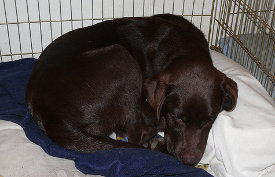|
Crate training is one of the most effective ways to teach a dog not to soil inside the house. Why does it work? Dogs naturally do not want to soil the area where they sleep. A crate gives your dog a space where he will not want to relieve himself. Once you define a space he shouldn't "go," it’s a lot easier to define the space where it's allowed. It's not just for puppies either. Older dogs can learn new tricks, and this is a very useful one. It's actually quite easy to learn how to crate train an older dog.
7 Easy Steps To Crate Training Older Dogs
1) Pick the right crate.
The crate should be large enough for your dog to stand up, lay down, and turn around. It should not be so large that your dog takes up only a small part of the crate. Here’s why: In a too-large crate, your dog will sleep on one side and go potty on the other. That eliminates any benefit of using a crate for house-training.
 We recommend crates from Midwest. They're better than other crates because they include a divider so you can custom-fit a crate to your dog's size, have a door specially-designed to take up less space, and are easily portable. Order your Midwest crate here. We recommend crates from Midwest. They're better than other crates because they include a divider so you can custom-fit a crate to your dog's size, have a door specially-designed to take up less space, and are easily portable. Order your Midwest crate here.
2) Make the crate a safe space.
This part is relatively easy since dogs naturally crave small spaces to feel secure. (If you’ve ever seen a dog hide under a bed or behind a couch when he’s scared, this is why.) Line it with a soft bed and throw in an old dirty shirt of yours so the crate has your smell in it. While you're at home, leave the crate open so your dog may enter and exit the crate freely. When you give your dog a new toy or treat, put it in the crate. This will give the crate positive, comforting associations.
Never use the crate as punishment.
3) Set reasonable expectations.
An adult dog has the physical ability to hold it for several hours at a time, but may not have learned to do so. Start with an hour at a time then build up to longer periods. Have a friend or neighbor let the dog out at reasonable intervals if you’re unable to do so. Hire a dog-sitter or dog-walker if necessary.
4) Stick to a routine.
Dogs are creatures of habit. When you’re trying to form the habit of going outside to potty, create a routine that encourages and rewards that behavior. Feed your dog meals at the same time each day, rather than leaving food down at all times. Take the dog outside immediately after each feeding, first thing in the morning, last thing at night, and as soon as you let him out of the crate. Use a command like “go potty” and when your dog does, shower him with praise.
5) Keep a close eye on your dog.
While you’re house-training, your dog should either be in your eyesight or in his crate. Recognize the signs of needing to go: walking slowly in circles, sniffing for a spot, and squatting. When you spot these signs, take your dog outside immediately and give the command.
If you see your dog starting to relieve himself indoors, make a sound like “Ah!” or a loud clap. This will startle him, which will most likely make him pause. Take that moment to take your dog outside. Use the command “go potty” again and reward your dog when he goes. This teaches him that inside is not OK and outside is.
6) Handle accidents appropriately.
There will be accidents. The key to correcting accidents is catching them as they happen.
Dogs live in the moment, so that’s when you need to correct mistakes. If you catch a mess after it’s happened, let it go. Don't rub your dog’s nose in it. It doesn’t help and in fact it hurts training. Your dog will connect fear with you, not with the mess.
Use a cleaner that breaks down the mess to prevent future accidents. When your dog smells a spot he’s relieved himself before, it makes him more likely to go in that spot again. That's good outside and bad inside. Many cleaners simply cover up the smell to a human nose, but that doesn’t trick a dog. An enzyme-based cleaner like this one actually breaks down the mess chemically so even your dog won't smell it.
7) Be patient and consistent.
It takes time to create new habits. By being patient and consistent, your dog will quickly learn what is expected of him.
There it is – 7 steps for how to crate train an older dog. These tried-and-true tips are the quickest method to teach your dog to relieve himself outdoors.
Don’t have a crate yet? The crate we recommend is sturdy, portable, and designed not to take up a lot of space. Click here to order your Midwest crate.
If you liked this, you may also like:
6 Reasons Why Crates Rock - Once your dog is crate trained, here are 6 other reasons to keep using the crate.
Dog Urine Grass Repair Solution - Dog urine sometimes causes yellow spots on grass. This cures it.
Bathing Dogs Made Easy - Sometimes accidents make messes.
Photo credit: riann cornelius
|